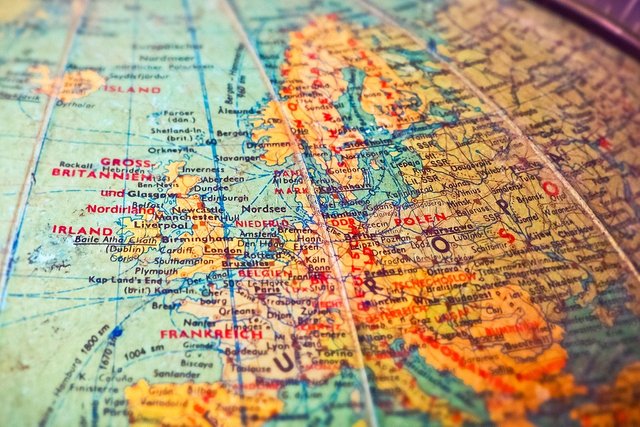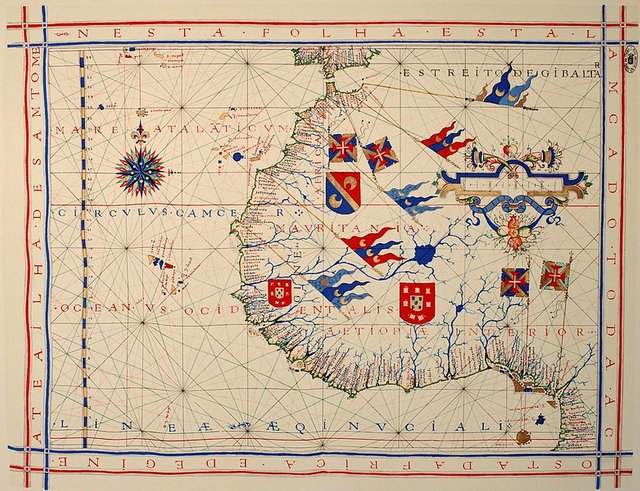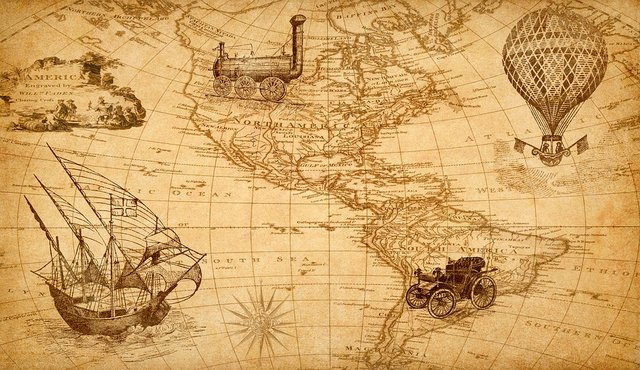INTRODUCTION TO CARTOGRAPHY - CARTOGRAPHIC SYMBOLIZATION & VISUAL VARIABLES
Hello everyone!
How are you doing today? I sincerely hope you are all having a wonderful day. Life has been handing me lemons lately and I had to go through so much while being extremely busy. That's the main reason why it took me more than a week to come back with another Engineering blog. However I decided to make lemonade, so here I am once again ready to share another Cartography blog with you guys and thus keep this series going. No time to waste though, so let's get this started!
As promised in a previous Cartography post concerning the use of color and pattern in the symbolization of geographic entities' quantitative characteristics, this is the thirteenth part of this Introduction to Cartography series. This time I am taking the chance to share broad information regarding the fundamental elements and theoretical problems of Cartographic Symbolization. We will also talk about visual variables and take a deeper look at the three main categories in which these variables are divided, so stay focused!
For those of you who are new to my blog, I'd like to let you know that you should always keep in mind that this is an introductory series about Cartography, which is the science and art of creating accurate 2D depictions of our 3D world. This actually means that I will be presenting broad information in a simplified manner so that we can have some fun while learning something new. And there's always a chance of learning a thing or two by reading through these blogs, so stay tuned!
Introduction
Maps are useful tools that are designed and created in order to provide spatial information regarding geographical characteristics with accuracy and efficiency. The need to study and depict the spatial elements of geographic phenomena and geographic entities with precision induced the demand for the creation of graphical symbols. The design and creation of all the various sorts of graphical symbols used by Cartographers is part of the process of Cartographic Symbolization. Cartographers are often puzzled by spatial characteristics and have a really hard time deciding which are the appropriate symbols to use in each map. Some spatial characteristics are described by generalized numbers, which only complicates things further as it is easy to make mistakes while deciding how to symbolize those characteristics.
The process of Cartographic Symbolization is a vital tool of map generalization. As far as Cartographers are concerned, our 3D world is comprised of spatial elements and the main objective is to wisely decide which of those should be depicted and how to achieve accurate representation of those and efficient communication with the user. If it all sounds cool, just wait until I mention how technology is actually making Cartographers' lives harder in this case, as spatial elements that exist in the real world have to be digitized with precision when working on a software. So what is the problem with that? Limitations. Digital 2D depictions of our 3D world are highly dependent on the technology available, which basically means that Cartographers have to adjust the spatial information utilized and presented with the available digital means.
As explained in previous parts of this Introduction to Cartography series, spatial elements of geographic phenomena and geographic entities that are chosen to be included and depicted have to be classified according to their attributes. The Classification of spatial elements is then followed by the process of Cartographic Symbolization, which is the process of utilizing visual variables in order to present data summary with efficiency, also referred to as the graphical encyption of Map Generalization. If you have been following then I suppose it is more than obvious that the process of Cartographic Symbolization is vital for every map's purpose. Unsuccessful symbolization can ruin the products of the process of Classification and result in a distorted view of reality. Unfortunately this also works the other way around, which basically means that the accurate symbolization of low quality data adds fake precision to the classification process.
Symbolization
The process of Cartographic Symbolization starts with the definition of the numeric values that refer to the characteristics of the spatial elements included. The next step includes the specification of the level of measurement that will be utilized in order to assist Cartographers in creating accurate visual represantations of all spatial elements that have been chosen to be presented. There are four different levels of measurement used in the creation of visual representations of spatial elements and this is something we will elaborate on later on in this blog. After the appropriate level of measurement is selected, Cartographers proceed to define the dimensions of spatial elements, which are divided in four categories according to each spatial element's geometric nature.
It is commonly accepted that all spatial elements can be represented by utilizing graphical symbols that stem from a combination of the level of measurement utilized and the dimensions of geographic entities depicted. This is the main reason why Cartographers have to define and even alter the initial level of measurement of the data that will be presented before deciding which specific symbols will be utilized. It is worth noting at this point that the process of defining the dimensions of spatial elements is also concluded before any decisions regarding symbols are made. If you have been reading so far then you probably realize that the level of measurement and the dimensions of spatial elements are key factors in Cartographic Symbolization. I would totally agree, that's why we are going to take a deeper look at each one of those processes.
Level of Measurement
All values regarding the spatial elements' characteristics can be measured based on one of the four scales (nominal, ordinal, interval, ratio) of measurement utilized by Cartographers. It is worth keeping in mind that each scale mentioned above contains all previous scales (nominal < ordinal < interval < ratio). So what does that mean? Well, the moral of the story is that Cartographers can always replace the scale of measurement with its previous category (e.g. ordinal to nominal or interval to ordinal). This process does not work the other way around though. I suppose it goes without saying that you can never replace the nominal scale of measurement.
Dimensions of Spatial Elements
All spatial elements' dimensions range from zero to three. A point in space is a 0D element, whereas a line is a 1D element. Furthermore, surfaces are obviously 2D elements and volumetric elements are 3D. Due to the fact that Cartography is all about 2D depictions of our 3D world, volumetric elements are presented with the utilization of symbols that are mainly comprised of points, lines or even surfaces. This goes to show that Cartographers have plenty of options in cases where the generalization of the dimensions of spatial elements is necessary, however the process of generalization (replacing the scale of measurement with its previous category) needs to be concluded with caution as it might induce errors regarding geographic position.
Visual Variables
As discussed previously in this series, there are three primary visual variables (size, orientation, shape) and three dimensions of color (intensity, saturation, hue) which are also known as primary visual variables. All six attributes mentioned represent a scale of measurement that refers to different characteristics of the same spatial elements. Cartographers have to be able to define the level of measurement represented by all visual variables and to reach conclusions regarding the efficiency of a visual variable regarding the map's purpose before it is used. Everything mentioned in this paragraph basically sums up the process in which appropriate symbols are designed. The main objective when designing symbols is to create a connection between a spatial elements' properties and a visual variable. Sounds simple but it's not. Doesn't it? Let's proceed to take a deeper look at the three categories of visual variables.
Ordered Visual Variables
The utilization of three of the primary visual variables mentioned above (intensity, size, saturation) in the design and creation of symbols give birth to visual classification. This is highly dependent on the way the human brain functions and interprets sensory information and is also the main reason why these three primary visual variables are known as Ordered Visual Variables. These variables are generally used for linear and surface characteristics , however they can also be used for the depiction of various characteristics of spatial elements that refer to all scales apart from the nominal scale. Intensity is probably the most significant of all Ordered Visual Variables and can be utilized to depict characteristics that refer to the interval scale and the ratio scale. Furhermore, size is one of the most commonly used visual variables and represents quantitative differences, whereas saturation is the least effective visual variable of all Ordered Visual Variables.
Differentiated Visual Variables
In this case we are dealing we another three primary visual variables (hue, orientation, shape) that are mentioned in this blog. These visual variables can be utilized to represent characteristics that only refer to the nominal scale of measurement. Hue is the visual variable that is most commonly used in order to depict altitude or temperature ranges, which is by the way an example of characteristics that do not refer to the nominal scale and therefore make this a bad choice. However it all can be fixed if numbers and specifications are included on the map. Orientation is a Differentiated Visual Variable that refers to the angles at which symbols are placed and is mainly used for characteristics that refer to the nominal scale as well. Last but never least, shape is another Differentiated Visual Variable used for the demonstration of qualitative differences which is very effective in cases of linear symbols.
Secondary Visual Variables
Surprise, surprise! There are three more visual variables (ordinance of pattern, texture of pattern, orientation of pattern) that are known as Secondary Visual Variables. These visual variables are created by the systematic repetition of fundamental graphical elements (points & lines) that gives birth to a visual outcome that is known as pattern. It is worth noting at this point that texture of pattern can be used as an Ordered Visual Variable in specific cases given that it has been meticulously concluded. The two remaining Secondary Visual Variables can be used as Differentiated Visual Variables. All variables are used in order to assist Cartographers in producing a satisfying visual outcome and to enhance the map's efficiency.
Alright everyone, that's it for today. This means we have reached the end of the thirteenth part of this Introduction to Cartography series. I would like to thank each and everyone of you for taking the time to read my work. I sincerely hope you had fun around here and did learn a thing or two. You can let me know if you do have any questions in the comments below. I always read and respond to all comments and do my best to provide detailed answers should there be any questions. More material coming within the next couple of days, so stay tuned and follow me at your own risk!
PREVIOUS PARTS OF THE SERIES:
INTRODUCTION TO CARTOGRAPHY - COLOR & PATTERN IN SYMBOLIZATION (Part I)
INTRODUCTION TO CARTOGRAPHY - COLOR & PATTERN IN SYMBOLIZATION (Part II)
IMAGE SOURCES:
REFERENCES:
University Textbooks & Course Lectures:
Χαρτογραφία Ι/ Cartography I -TSOULOS(National Technical University of Athens, School of Rural & Surveying Engineering, Course Lecture Notes)
Xαρτογραφία ΙΙ /Cartography II -NAKOS BYRON(National Technical University of Athens, School of Rural & Surveying Engineering, Course Lecture Notes)
Internet Links:
http://gistbok.ucgis.org/bok-topics/symbolization-and-visual-variables
https://prism.ucalgary.ca/bitstream/handle/1880/45758/2001-693-16.pdf?sequence=2&isAllowed=y
http://pro.arcgis.com/en/pro-app/help/mapping/layer-properties/symbolization.htm
Thank you for your attention!
Hope you enjoyed this post and did learn a thing or two.
Follow me and stay tuned for more engineering blogs.
Highest Regards
@lordneroo






Missed a couple in my semi-absence!
Just roving sweatless through a winter-ish summer :D Ruth tells me it's the same over there.
Pff. Only a week. Kids stuff.
Despite the rather academic language, the post was quite clear. However, it would be nice if every section was punctuated with examples of what was just discussed, not just whole maps. Zoomed-in pics perhaps of a specific symbol or color, and then a note saying "this means this"? Would do much to make things stick, though it would be more time-consuming. But nothing wrong with tantric posting :D
Hey man, good to see you here and of course to have you back since last week!
Good to know you're fine, yeah the weather is kind of weird here. Thanks for your suggestion, the truth is I'm having a hard time finding free images that fit my blog's purpose no matter how hard I try. I could beat around the bush and claim that I do it just to see who's been watching and learning so far, but I'm not that type. ;)
Thanks for dropping by and leaving valuable feedback, I appreciate your kind words!
Yeah the image thing isn't easy. I often have to be creative even about that, or use photoshop and doodle something that will hopefully be tolerable.
Just joining this page for the first time. I guess I really have a lot of ground to cover. Thanks for giving us this.
I am @teekingtv and I write STEM.
Τhanks for passing by @teekingtv!
Anytime sir!
καλήμερα φίλε μου.. ειναι τέλειο!!! :)
Καλησπέρα Νικ! Να 'σαι καλά φίλε!
Hi @lordneroo!
Your post was upvoted by utopian.io in cooperation with steemstem - supporting knowledge, innovation and technological advancement on the Steem Blockchain.
Contribute to Open Source with utopian.io
Learn how to contribute on our website and join the new open source economy.
Want to chat? Join the Utopian Community on Discord https://discord.gg/h52nFrV
Thanks for the support!
Finally out of the shadows of being a sorta resteem bot with a great and insightful post... Very well articulated.
Cool stuff @lordneroo
Hehe! Thanks for passing by @gidionline! I appreciate your kind words and support!
Have a good day :)